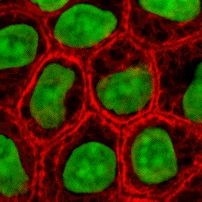|
Bioprocessor
A bioprocessor is a miniaturized bioreactor capable of culturing mammalian, insect and microbial cells. Bioprocessors are capable of mimicking performance of large-scale bioreactors, hence making them ideal for laboratory scale experimentation of cell culture processes. Bioprocessors are also used for concentrating bioparticles (such as cells) in bioanalytical systems. Microfluidic processes such as electrophoresis Electrophoresis, from Ancient Greek ἤλεκτρον (ḗlektron, "amber") and φόρησις (phórēsis, "the act of bearing"), is the motion of dispersed particles relative to a fluid under the influence of a spatially uniform electric fie ... can be implemented by bioprocessors to aid in DNA isolation and purification. References Biochemical engineering Biotechnology {{biotech-stub ... [...More Info...] [...Related Items...] OR: [Wikipedia] [Google] [Baidu] |
Bioreactor
A bioreactor refers to any manufactured device or system that supports a biologically active environment. In one case, a bioreactor is a vessel in which a chemical process is carried out which involves organisms or biochemically active substances derived from such organisms. This process can either be aerobic or anaerobic. These bioreactors are commonly cylindrical, ranging in size from litres to cubic metres, and are often made of stainless steel. It may also refer to a device or system designed to grow cells or tissues in the context of cell culture. These devices are being developed for use in tissue engineering or biochemical/bioprocess engineering. On the basis of mode of operation, a bioreactor may be classified as batch, fed batch or continuous (e.g. a continuous stirred-tank reactor model). An example of a continuous bioreactor is the chemostat. Organisms or biochemically active substances growing in bioreactors may be submerged in liquid medium or may be anchored to th ... [...More Info...] [...Related Items...] OR: [Wikipedia] [Google] [Baidu] |
Miniaturization
Miniaturization ( Br.Eng.: ''Miniaturisation'') is the trend to manufacture ever smaller mechanical, optical and electronic products and devices. Examples include miniaturization of mobile phones, computers and vehicle engine downsizing. In electronics, the exponential scaling and miniaturization of silicon MOSFETs (MOS transistors) leads to the number of transistors on an integrated circuit chip doubling every two years, an observation known as Moore's law. This leads to MOS integrated circuits such as microprocessors and memory chips being built with increasing transistor density, faster performance, and lower power consumption, enabling the miniaturization of electronic devices. History The history of miniaturization is associated with the history of information technology based on the succession of switching devices, each smaller, faster, cheaper than its predecessor. During the period referred to as the Second Industrial Revolution, miniaturization was confined ... [...More Info...] [...Related Items...] OR: [Wikipedia] [Google] [Baidu] |
Cell Culture
Cell culture or tissue culture is the process by which cells are grown under controlled conditions, generally outside of their natural environment. The term "tissue culture" was coined by American pathologist Montrose Thomas Burrows. This technique is also called micropropagation. After the cells of interest have been isolated from living tissue, they can subsequently be maintained under carefully controlled conditions the need to be kept at body temperature (37 °C) in an incubator. These conditions vary for each cell type, but generally consist of a suitable vessel with a substrate or rich medium that supplies the essential nutrients (amino acids, carbohydrates, vitamins, minerals), growth factors, hormones, and gases ( CO2, O2), and regulates the physio-chemical environment ( pH buffer, osmotic pressure, temperature). Most cells require a surface or an artificial substrate to form an adherent culture as a monolayer (one single-cell thick), whereas others can ... [...More Info...] [...Related Items...] OR: [Wikipedia] [Google] [Baidu] |
Laboratory
A laboratory (; ; colloquially lab) is a facility that provides controlled conditions in which scientific or technological research, experiments, and measurement may be performed. Laboratory services are provided in a variety of settings: physicians' offices, clinics, hospitals, and regional and national referral centers. Overview The organisation and contents of laboratories are determined by the differing requirements of the specialists working within. A physics laboratory might contain a particle accelerator or vacuum chamber, while a metallurgy laboratory could have apparatus for casting or refining metals or for testing their strength. A chemist or biologist might use a wet laboratory, while a psychologist's laboratory might be a room with one-way mirrors and hidden cameras in which to observe behavior. In some laboratories, such as those commonly used by computer scientists, computers (sometimes supercomputers) are used for either simulations or the analysis of data ... [...More Info...] [...Related Items...] OR: [Wikipedia] [Google] [Baidu] |
Cell Culture
Cell culture or tissue culture is the process by which cells are grown under controlled conditions, generally outside of their natural environment. The term "tissue culture" was coined by American pathologist Montrose Thomas Burrows. This technique is also called micropropagation. After the cells of interest have been isolated from living tissue, they can subsequently be maintained under carefully controlled conditions the need to be kept at body temperature (37 °C) in an incubator. These conditions vary for each cell type, but generally consist of a suitable vessel with a substrate or rich medium that supplies the essential nutrients (amino acids, carbohydrates, vitamins, minerals), growth factors, hormones, and gases ( CO2, O2), and regulates the physio-chemical environment ( pH buffer, osmotic pressure, temperature). Most cells require a surface or an artificial substrate to form an adherent culture as a monolayer (one single-cell thick), whereas others can ... [...More Info...] [...Related Items...] OR: [Wikipedia] [Google] [Baidu] |
Electrophoresis
Electrophoresis, from Ancient Greek ἤλεκτρον (ḗlektron, "amber") and φόρησις (phórēsis, "the act of bearing"), is the motion of dispersed particles relative to a fluid under the influence of a spatially uniform electric field. Electrophoresis of positively charged particles ( cations) is sometimes called cataphoresis, while electrophoresis of negatively charged particles (anions) is sometimes called anaphoresis. The electrokinetic phenomenon of electrophoresis was observed for the first time in 1807 by Russian professors Peter Ivanovich Strakhov and Ferdinand Frederic Reuss at Moscow University, who noticed that the application of a constant electric field caused clay particles dispersed in water to migrate. It is ultimately caused by the presence of a charged interface between the particle surface and the surrounding fluid. It is the basis for analytical techniques used in chemistry for separating molecules by size, charge, or binding affinity. Electr ... [...More Info...] [...Related Items...] OR: [Wikipedia] [Google] [Baidu] |
Biochemical Engineering
Biochemical engineering, also known as bioprocess engineering, is a field of study with roots stemming from chemical engineering and biological engineering. It mainly deals with the design, construction, and advancement of unit processes that involve biological organisms (such as fermentation) or organic molecules (often enzymes) and has various applications in areas of interest such as biofuels, food, pharmaceuticals, biotechnology, and water treatment processes. The role of a biochemical engineer is to take findings developed by biologists and chemists in a laboratory and translate that to a large-scale manufacturing process. History For hundreds of years, humans have made use of the chemical reactions of biological organisms in order to create goods. In the mid-1800s, Louis Pasteur was one of the first people to look into the role of these organisms when he researched fermentation. His work also contributed to the use of pasteurization, which is still used to this day. B ... [...More Info...] [...Related Items...] OR: [Wikipedia] [Google] [Baidu] |



